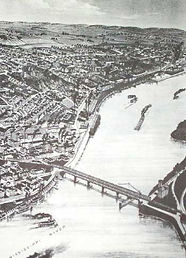
HISTORY
... established in 1851 along the banks of the Mississippi
In 1828, President John Quincy Adams formally declared that all lands to the east of the Mississippi were to be sold to settlers gradually moving their way westward. This resulted in Indian tribes being forced to the west. Chief Black Hawk and 2,000 of his followers refused to move, resulting in the "Black Hawk War. (Source: State of Iowa)
The Treaty of 1826 was signed near what is now College Street in East Davenport. The Treaty was and agreement between Chief Keokuk and the U.S. Government, in which the Indians relinquished a large part of waht is now, Iowa. Black Hawk, who no longer had power after his capture during the war, camped with his remaining warriors high about the river at the present day Lindsay Park. During the gathering for the treaty signing, famed western artist, George Catlin, painted and stetched the Indians, including the chief. (Catlin's painting of Chief Black Hawk)


The Village area was known to the rivermen in 1840 as "Stubb's Eddy" for the hermit cave dweller, James R. Stubbs, who lived in a mound (thus Mound St) near the river. East Davenport would eventually be founded at the foot of the 18-mile upper rapids of the Mississippi River. Now controlled by the lock and dam system, the rapids were claimed to be the longest in the world.
*Antione LeClaire, part Indian and part Caucasian, served as a translator and eventually became an East Davenport entrepreneur. (Pictured left)
The Village was founded in 1851 as a pre-Civil War logging town. The first industry was a steam-powered sawmill opened by Robert Christie. Logs from the north were rafted down the river to the mills. In 1856, the first railroad bridge to span the Mississippi was built between Rock Island and the spot on the Iowa side directly south of the Village. It was of the utmost importance in getting lumber from the sawmills to the frontier. However, when the Effie Afton riverboat hit the bridge, it became the subject of a lawsuit between the riverboat and the railroad which was litigated by a young lawyer named Abraham Lincoln, who successfully defended the railroad interests. Today the log trestle still stands as the last tangible remnant of the first railroad west. The Village is the location of the Civil War Camp McClellan in 1861. Also, the site in 1862 of the Camp Kearney Indian prison.
Structures including Colonel George L. Davenport's "Claim House", the first house built west of the Mississippi is located in the Village.
In 1980, the area became listed as the Village of East Davenport Historic District on the National Registry of Historic Places.


